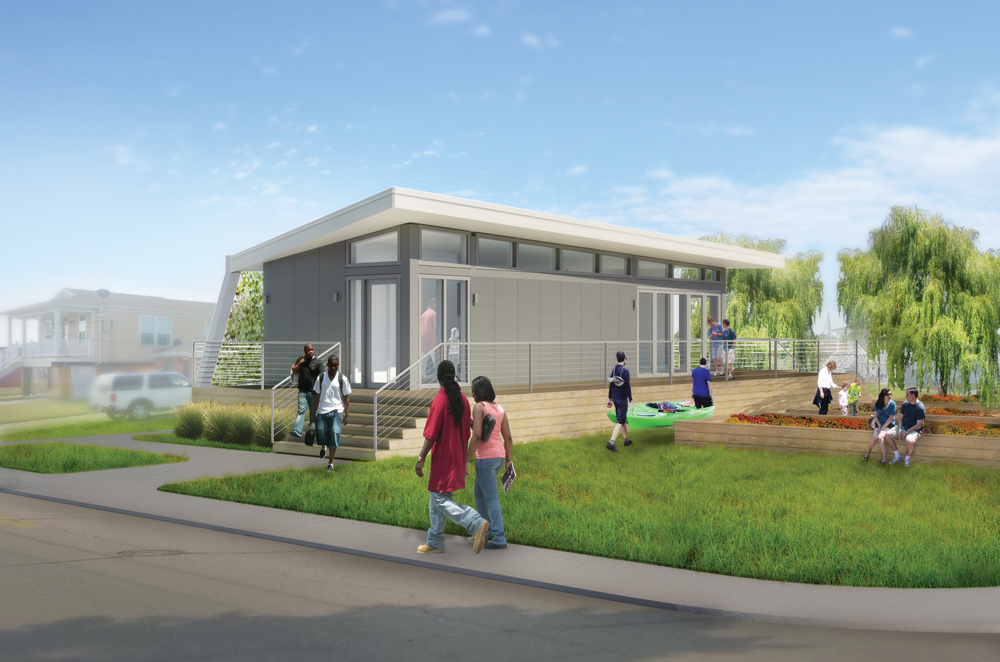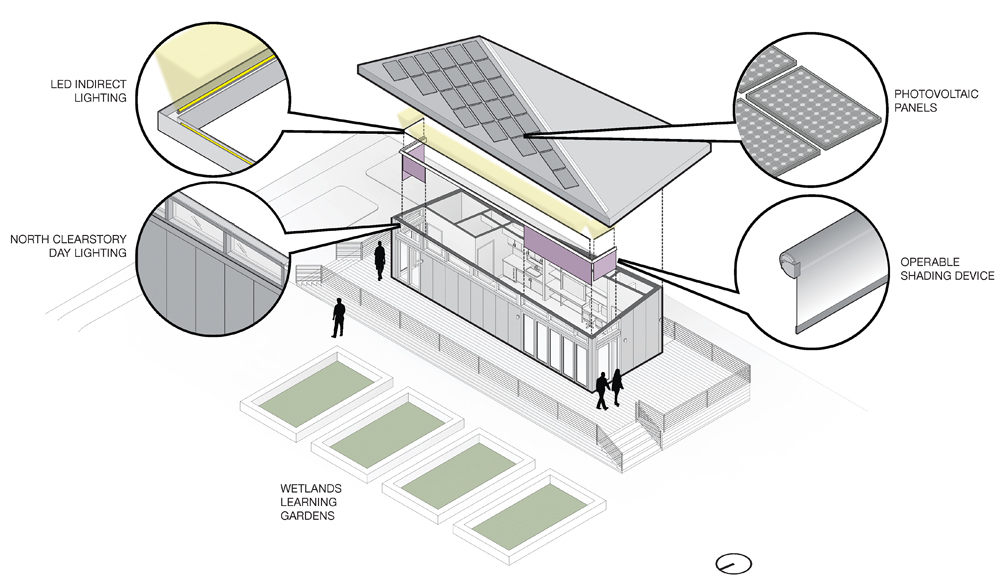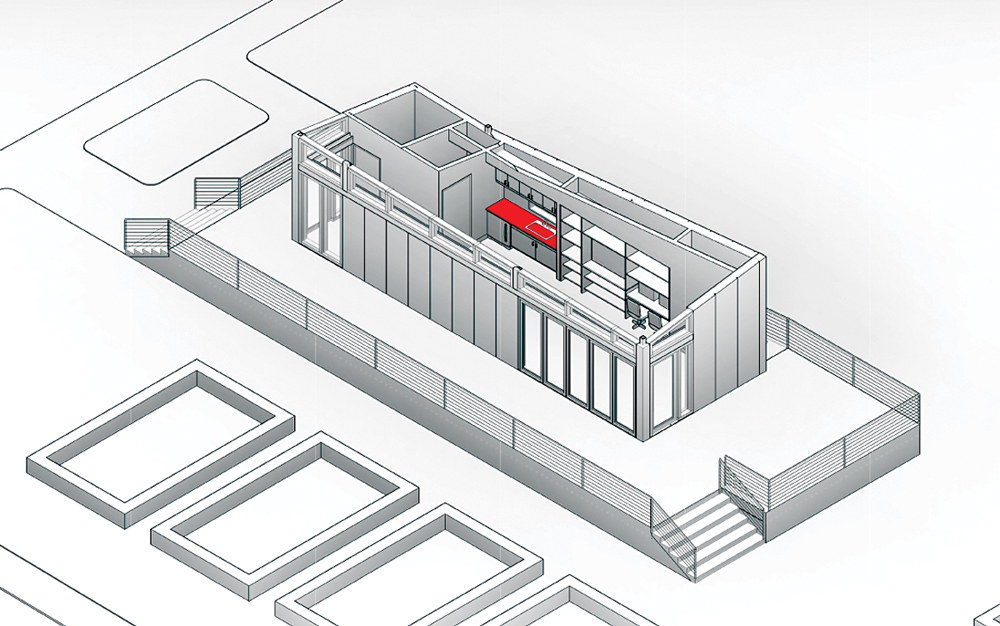Building Design+Construction has partnered with building product manufacturers and the Lower 9th Ward Center for Sustainable Engagement and Development (CSED) to create a modular classroom/lab/community center, on display at the GreenZone exhibit during Greenbuild 2014 in New Orleans, October 21-23.
At the conclusion of Greenbuild, the Environment Education Classroom will revert to the possession of the CSED and move to its permanent Lower 9th Ward home in a residential block south of the Bayou Bienvenue Wetlands Triangle viewing platform. It will serve as a community center and K-12 classroom for educating students on water quality, water conservation, storm water management, and resiliency.
Designed by New Orleans firm Eskew+Dumez+Ripple (EDR), recipient of the 2014 AIA Architecture Firm Award, and TLC Engineering for Architecture, and built by local design-builder Broadmoor LLC, the structure targets net-zero energy use. Sustainable design elements include a pitched butterfly roof to collect and transport rainwater to polypropylene tanks underneath the building.
How you can contribute
After being on display at the Morial Convention Center at Greenbuild October 21-23, the Environment Education Classroom will revert to the possession of the CSED. The 560-sf modular structure will be moved to its permanent home in a residential block just south of the Bayou Bienvenue Wetlands Triangle viewing platform.
Moving the structure from the convention center and setting it up at the CSED site will require about $30,000 in site work to lay the foundation, connect the utilities, and construct ADA-compliant decks and entryways, according to USGBC Louisiana Executive Director Shannon Stage.
USGBC Louisiana, a 501(c)(3) charitable entity, is seeking tax-deductible donations from Greenbuild attendees, AEC firms, and others interested in the CSED Environment Education Classroom to help offset those costs. Credit-card donations may be made via the USGBC Louisiana website, usgbclouisiana.org.
Any excess funds that are collected will be used for educational materials and ongoing operations of the facility, says Stage.
The water will be reused to irrigate wetland beds. The building is 100% daylit per LEED v4 requirements, enhanced by a triangular piece of glass around the entire façade that allows further daylight penetration into the structure.
The GreenZone sponsors include: Access Lighting, Accoya, ASSA ABLOY, Bayer MaterialScience, Carlisle Syntec Systems, CENTRIA, LG, Mecho Systems, and Modular Building Institute.
About the Structure
The Environment Education Classroom will serve a variety of functions in the Lower 9th Ward community. It will be an education center, meeting space, and laboratory all in one and within a footprint of 15 feet by 40 feet.
The main space is designed to be as open and flexible as possible, complete with movable furniture to be reconfigured as needed. Since the number of people sharing the building at any one time can change, EDR went with a demand-controlled ventilation mechanical system, which will respond to the number of occupants in the room at any given time. The architects wanted the building to be 100% daylit, per LEED v4, and so engaged extensive daylight simulations for testing.
Taking that indoor-outdoor connection a step further, a portion of the north facade will feature a folding wall system that can be opened and closed as desired.
From the exterior, the pitched butterfly roof is one of the visual highlights. But it's not just beauty for beauty's sake—the roof will be able to collect rainwater and carry it down to the polypropylene tanks underneath the building; The rainwater will be reused to irrigate the wetland beds CSED plans to install around the building.
For more information on the Environment Education Classroom, visit www.BDCnetwork.com/greenzone2014.
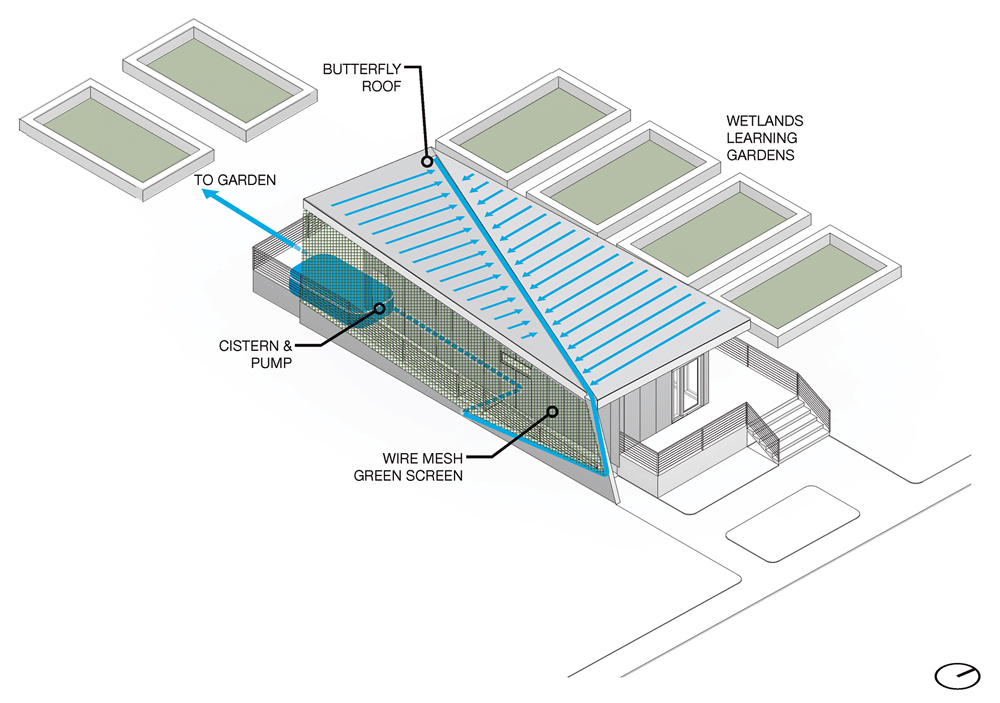
Schematic by New Orleans design firm Eskew+Dumez+Ripple reveals some of the sustainbility features of the modular classroom/lab/community center. The facilty’s focus on water/stormwater education is made apparent to visitors and the community via the rainwater retention system on the roof, the cistern and pump, the vegetated rainscreen, and wetlands learning gardens. Design/build firm Broadmoor LLC is in charge of construction. All illustrations: Eskew+Dumez+Ripple
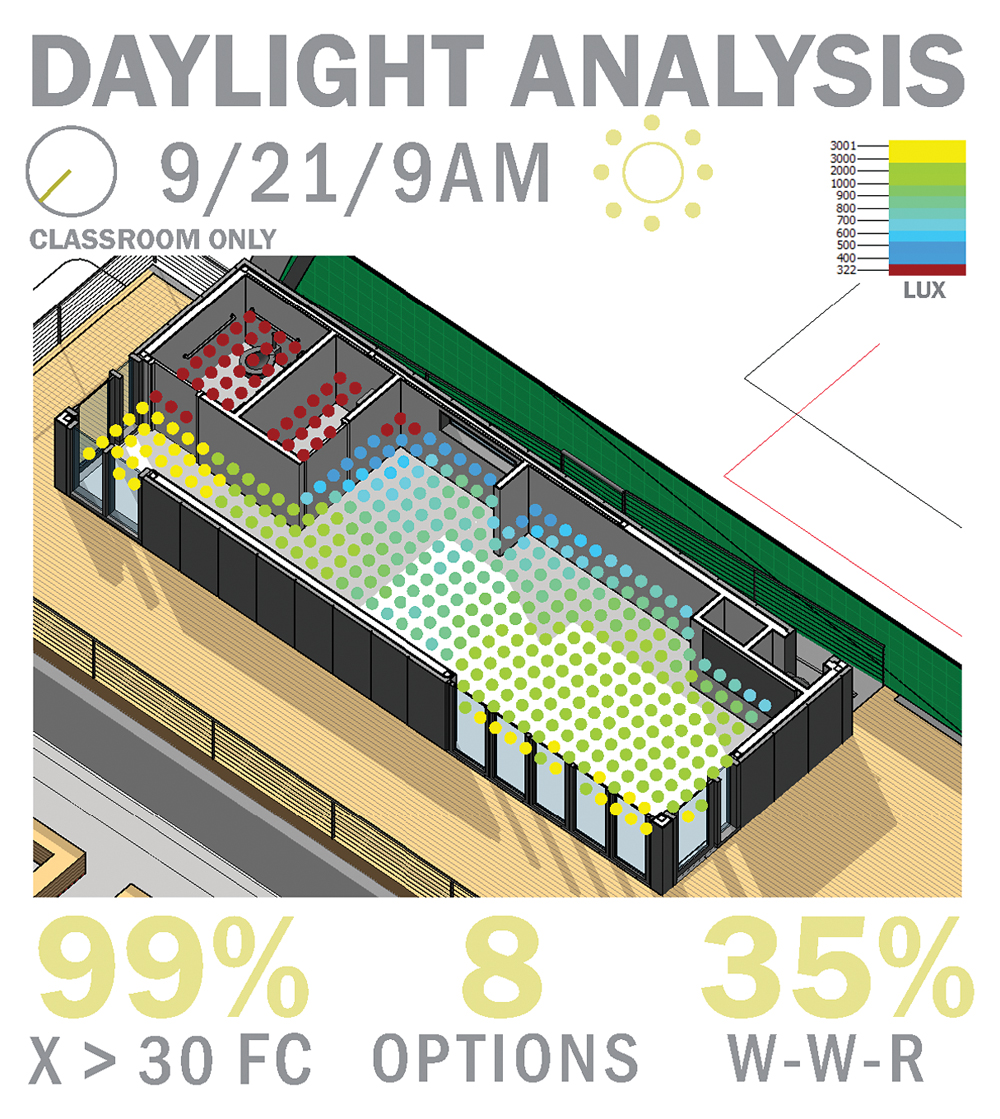
Eskew+Dumez+Ripple conducted extensive daylight and energy analyses to make the modular facility as energy efficient as possible under LEED v4.
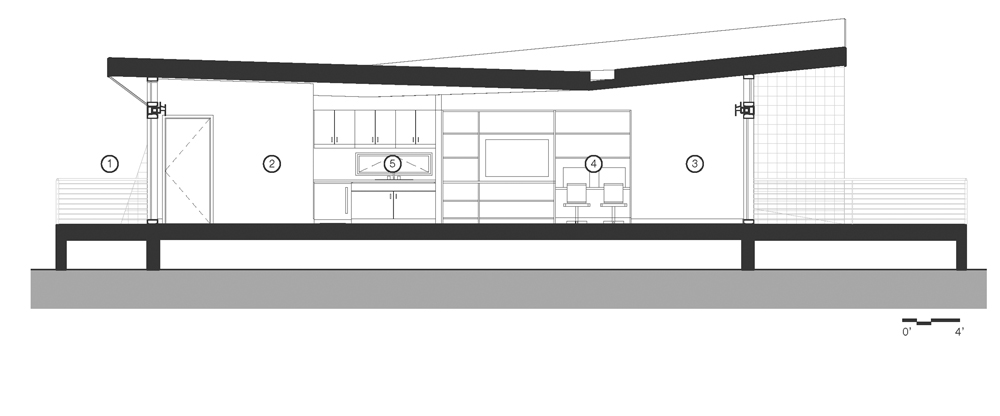
1. Entry 2. Exhibit display 3. Classroom 4. Computer Station 5. Kitchen. Section of Environment Education Classroom reveals multiple use options in a compact space. Designer Eskew+Dumez+Ripple was named AIA Architecture Firm for 2014.
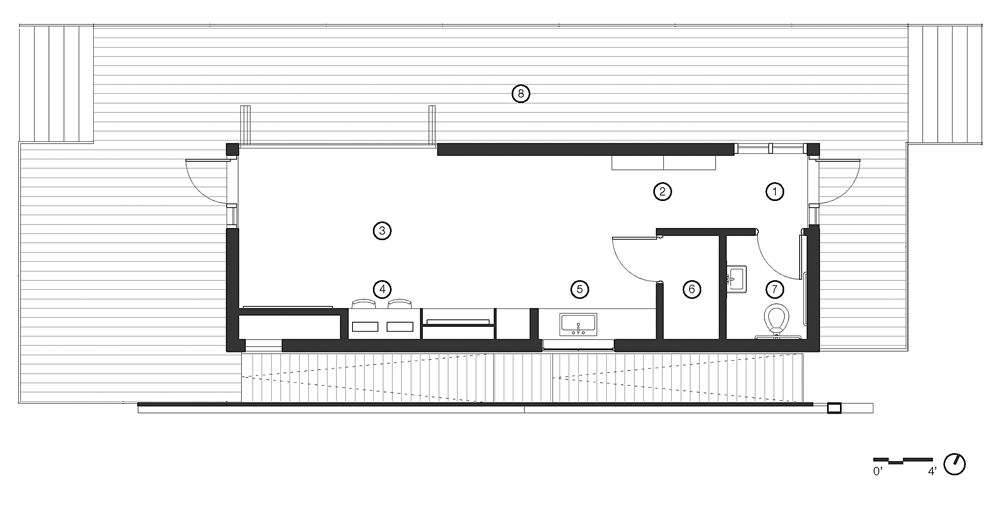
1. Entry 2. Exhibit display 3. Classroom 4. Computer Station 5. Kitchen 6. Closet 7. Toilet Room 8. Deck. Floor plan of the 560-sf Environment Education Center. Designers from Eskew+Dumez+Ripple worked pro bono with design/build experts from Broadmoor LLC to gain efficient use of the tight space. The facility will be used as a water/stormwater classroom for K-12 students, as a community center, and as a water-research lab.
Schematic by Eskew+Dumez+Ripple shows some of the sustainable strategies being employed in the module. Design-build firm Broadmoor LLC has used the project as an education opportunity for a dozen of its workers.
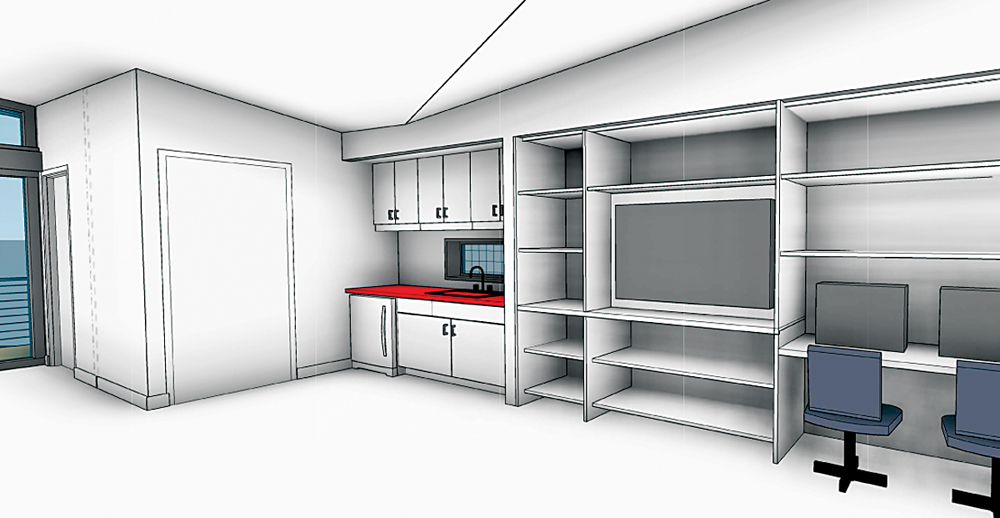
Renderings by Eskew+Dumez+Ripple provide advanced views of the Environment Education Classroom, at this writing under construction at Broadmoor LLC. Materials and systems for the project were donated by Access Lighting, Accoya, ASSA ABLOY, Bayer MaterialScience, Carlisle SynTec, CENTRIA, LG, and MechoSystems; the Modular Building Institute provided technical guidance. The facility will be sited about 100 yards from Bayou Bienvenue in the 9th Ward.
Related Stories
| Nov 9, 2010
Just how green is that college campus?
The College Sustainability Report Card 2011 evaluated colleges and universities in the U.S. and Canada with the 300 largest endowments—plus 22 others that asked to be included in the GreenReportCard.org study—on nine categories, including climate change, energy use, green building, and investment priorities. More than half (56%) earned a B or better, but 6% got a D. Can you guess which is the greenest of these: UC San Diego, Dickinson College, University of Calgary, and Dartmouth? Hint: The Red Devil has turned green.
| Nov 3, 2010
First of three green labs opens at Iowa State University
Designed by ZGF Architects, in association with OPN Architects, the Biorenewable Research Laboratory on the Ames campus of Iowa State University is the first of three projects completed as part of the school’s Biorenewables Complex. The 71,800-sf LEED Gold project is one of three wings that will make up the 210,000-sf complex.
| Nov 3, 2010
Park’s green education center a lesson in sustainability
The new Cantigny Outdoor Education Center, located within the 500-acre Cantigny Park in Wheaton, Ill., earned LEED Silver. Designed by DLA Architects, the 3,100-sf multipurpose center will serve patrons of the park’s golf courses, museums, and display garden, one of the largest such gardens in the Midwest.
| Nov 3, 2010
Seattle University’s expanded library trying for LEED Gold
Pfeiffer Partners Architects, in collaboration with Mithun Architects, programmed, planned, and designed the $55 million renovation and expansion of Lemieux Library and McGoldrick Learning Commons at Seattle University. The LEED-Gold-designed facility’s green features include daylighting, sustainable and recycled materials, and a rain garden.
| Nov 3, 2010
Recreation center targets student health, earns LEED Platinum
Not only is the student recreation center at the University of Arizona, Tucson, the hub of student life but its new 54,000-sf addition is also super-green, having recently attained LEED Platinum certification.
| Nov 3, 2010
Designs complete for new elementary school
SchenkelShultz has completed design of the new 101,270-sf elementary Highlands Elementary School, as well as designs for three existing buildings that will be renovated, in Kissimmee, Fla. The school will provide 48 classrooms for 920 students, a cafeteria, a media center, and a music/art suite with outdoor patio. Three facilities scheduled for renovations total 19,459 sf and include an eight-classroom building that will be used as an exceptional student education center, a older media center that will be used as a multipurpose building, and another building that will be reworked as a parent center, with two meeting rooms for community use. W.G. Mills/Ranger is serving as CM for the $15.1 million project.
| Nov 3, 2010
Virginia biofuel research center moving along
The Sustainable Energy Technology Center has broken ground in October on the Danville, Va., campus of the Institute for Advanced Learning and Research. The 25,000-sf facility will be used to develop enhanced bio-based fuels, and will house research laboratories, support labs, graduate student research space, and faculty offices. Rainwater harvesting, a vegetated roof, low-VOC and recycled materials, photovoltaic panels, high-efficiency plumbing fixtures and water-saving systems, and LED light fixtures will be deployed. Dewberry served as lead architect, with Lord Aeck & Sargent serving as laboratory designer and sustainability consultant. Perigon Engineering consulted on high-bay process labs. New Atlantic Contracting is building the facility.
| Nov 3, 2010
Dining center cooks up LEED Platinum rating
Students at Bowling Green State University in Ohio will be eating in a new LEED Platinum multiuse dining center next fall. The 30,000-sf McDonald Dining Center will have a 700-seat main dining room, a quick-service restaurant, retail space, and multiple areas for students to gather inside and out, including a fire pit and several patios—one of them on the rooftop.
| Nov 2, 2010
Cypress Siding Helps Nature Center Look its Part
The Trinity River Audubon Center, which sits within a 6,000-acre forest just outside Dallas, utilizes sustainable materials that help the $12.5 million nature center fit its wooded setting and put it on a path to earning LEED Gold.
| Oct 27, 2010
Grid-neutral education complex to serve students, community
MVE Institutional designed the Downtown Educational Complex in Oakland, Calif., to serve as an educational facility, community center, and grid-neutral green building. The 123,000-sf complex, now under construction on a 5.5-acre site in the city’s Lake Merritt neighborhood, will be built in two phases, the first expected to be completed in spring 2012 and the second in fall 2014.


